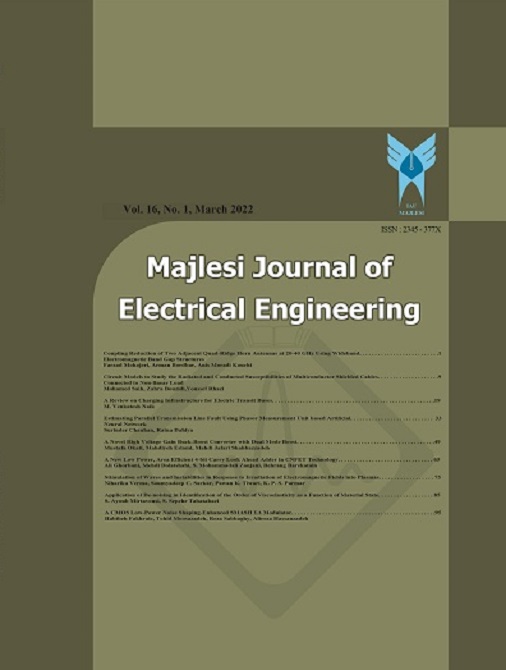Document Type : Reseach Article
Authors
Department of Electrical Engineering, Annamalai University, Chidambaram, India.
Abstract
Short-term electrical load forecasting plays a pivotal role in modern energy systems, addressing the need for accurate predictions of electricity demand within a time frame ranging from a few hours to a few days. The implications of inaccurate predictions extend beyond operational challenges to potential economic and environmental consequences, emphasizing the critical role that short-term electrical load forecasting plays in the modern energy landscape. The purpose of this research is to address the aforementioned consequences by developing an optimally configured Long Short-Term Memory (LSTM) model for predicting short-term electrical load forecasting in Tamil Nadu, specifically focusing on India's Villupuram region. While LSTM models are recognized for their overall effectiveness, their performance in short-term electrical load forecasting necessitates a tailored approach. Hyperparameter optimization is the appropriate choice for configuring the LSTM model for short-term electrical load forecasting. The manual or trial-and-error process in hyperparameter tuning is time-consuming and complex to compute. To address this, the research integrates the Cauchy-distributed Harris Hawks Optimization (Cd-HHO) approach for the optimal configuration of the LSTM model. The optimally configured LSTM through Cd-HHO consistently achieves lower Mean Squared Error (MSE) compared to other state-of-the-art methods, which is 0.7225 in the 2017 database, 0.974 in the 2018 database, and 0.116 in the 2019 database.
Keywords
- Liang, D. Niu, and W.C. Hong, “Short term load forecasting based on feature extraction and improved general regression neural network model,” Energy, vol.166, pp.653-663, Jan. 2019. https://doi.org/10.1016/j.energy.2018.10.119
- Guo, K. Zhou, X. Zhang, and S. Yang, “A deep learning model for short-term power load and probability density forecasting,” Energy, vol.160, pp.1186-1200, Oct.2018. https://doi.org/10.1016/j.energy.2018.07.090
- S. Khan, S.M. Ali, Z. Ullah, I. Sami, B. Khan, C.A. Mehmood, U. Farid, J. Saleem, and J.S. Ro, “Statistical energy information and analysis of Pakistan economic corridor based on strengths, availabilities, and future roadmap,” IEEE Access,vol.8, pp.169701-169739, Sep.2020. DOI: 10.1109/ACCESS.2020.3023647
- K. Lee, W. Shi, R. Gadh, and W. Kim, “Design and implementation of a microgrid energy management system,” Sustainability,vol.8, no.11, pp.1143, Nov. 2016. https://doi.org/10.3390/su8111143
- N. Fallah, R.C. Deo, M. Shojafar, M. Conti, and S. Shamshirband, “Computational intelligence approaches for energy load forecasting in smart energy management grids: state of the art, future challenges, and research directions,” Energies, vol.11, no.3, pp.596, Mar.2018. https://doi.org/10.3390/en11030596
- Kim, H.G. Son, and S. Kim, “Short term electricity load forecasting for institutional buildings”, Energy Rep, vol.5, pp.1270-1280, Nov.2019. https://doi.org/10.1016/j.egyr.2019.08.086
- Song, J. Wang, and H. Lu, “A novel combined model based on advanced optimization algorithm for short-term wind speed forecasting,” Appl. Energy, vol.215, pp.643-658, Apr.2019. https://doi.org/10.1016/j.apenergy.2018.02.070
- Zhao, C. Wang, J. Su, and J. Wang, “Research and application based on the swarm intelligence algorithm and artificial intelligence for wind farm decision system”, Renew. Energ, vol.134, pp.681-697, Apr.2019. https://doi.org/10.1016/j.renene.2018.11.061
- Xiao, W. Shao, C. Wang, K. Zhang, and H. Lu, “Research and application of a hybrid model based on multi-objective optimization for electrical load forecasting,”Appl.Energy, vol.180, pp.213-233, Oct.2016. https://doi.org/10.1016/j.apenergy.2016.07.113
- Ceperic, V.Ceperic, and A. Baric, “A strategy for short-term load forecasting by support vector regression machines,”IEEE Trans. Power Syst, vol.28, no.4, pp.4356-4364, Jul. 2013. doi: 10.1109/TPWRS.2013.2269803
- Chen, and D. Zhang, “Theory-guided deep-learning for electrical load forecasting (TgDLF) via ensemble long short-term memory,”Adv. Appl, vol.1, pp.100004, Feb.2021. https://doi.org/10.1016/j.adapen.2020.100004
- Zhang, C.H.E.N. Yuntian, and M.E.N.G. Jin, “Synthetic well logs generation via Recurrent Neural Networks,”Pet. Explor. Dev, vol.45, no.4, pp.629-639, Aug.2018. https://doi.org/10.1016/S1876-3804(18)30068-5
- S. Kwon, R.J. Park, and K.B. Song, “Short-term load forecasting based on deep neural networks using LSTM layer,”J. Electr. Eng. Technol, vol.15, pp.1501-1509, Jul.2020. https://doi.org/10.1007/s42835-020-00424-7
- Reimers, and I. Gurevych, “Optimal hyperparameters for deep lstm-networks for sequence labeling tasks,” arXiv preprint arXiv:1707.06799, Jul.2017.
https://doi.org/10.48550/arXiv.1707.06799 - Bergstra, and Y. Bengio, “Random search for hyper-parameter optimization,” J. Mach. Learn. Res, vol.13, no.2, Feb.2012. https://www.jmlr.org/papers/v13/bergstra12a.html
- Bouktif, A. Fiaz, A. Ouni, and M.A. Serhani, “Multi-sequence LSTM-RNN deep learning and metaheuristics for electric load forecasting,”Energies, vol.13, no.2, pp.391, Jan.2020. https://doi.org/10.3390/en13020391
- A. Ali, H. Zhangang, and W.B. Hang, “Cooperative path planning of multiple UAVs by using max–min ant colony optimization along with cauchy mutant operator,” Fluct. Noise Lett, vol.20, no.01, pp.2150002, Feb.2021. https://doi.org/10.1142/S0219477521500024
- Azeem, I. Ismail, S.M. Jameel, and V.R. Harindran, “Electrical load forecasting models for different generation modalities: a review,”IEEE Access, vol.9, pp.142239-142263, Oct.2021. DOI: 10.1109/ACCESS.2021.3120731
- Wang, J. Wang, and Y. Xu, “A novel combined model based on hybrid optimization algorithm for electrical load forecasting,” Appl. Soft Comput, vol.82, pp.105548, Sep.2019. https://doi.org/10.1016/j.asoc.2019.105548
- Javed, K. Ijaz, M. Jawad, E.A. Ansari, N. Shabbir, L. Kütt, and O. Husev, “Exploratory data analysis based short-term electrical load forecasting: A comprehensive analysis,”Energies, vol.14, no.17, pp.5510, Sep.2021. https://doi.org/10.3390/en14175510
- B. Tayab, A. Zia, F. Yang, J. Lu, and M. Kashif, “Short-term load forecasting for microgrid energy management system using hybrid HHO-FNN model with best-basis stationary wavelet packet transform,” Energy, vol.203, pp.117857, Jul.2020. https://doi.org/10.1016/j.energy.2020.117857
- Yazici, O. F. Beyca, and D. Delen, "Deep-learning-based short-term electricity load forecasting: A real case application," Eng. Appl. Artif. Intell., vol.109, pp.104645, Mar.2022. https://doi.org/10.1016/j.engappai.2021.104645
- Li, W.Huang, G. Hu, and J. Li, "Ultra-short term power load forecasting based on CEEMDAN-SE and LSTM neural network," Energy and Buildings, vol.279, pp.112666, Jan.2023. https://doi.org/10.1016/j.enbuild.2022.112666
- Shirzadi, A. Nizami, M. Khazen, and M. Nik-Bakht, “Medium-term regional electricity load forecasting through machine learning and deep learning,”Designs, vol.5, no.2, pp.27, Apr.2021. https://doi.org/10.3390/designs5020027
- Li, W.W. Ng, T. Wang, M. Pelillo, and S. Kwong, “HELP: An LSTM-based approach to hyperparameter exploration in neural network learning,”Neurocomputing, vol.442, pp.161-172, Jun.2021. https://doi.org/10.1016/j.neucom.2020.12.133
- Liu, D. Zhao, F. Yu, A.A. Heidari, C. Li, J. Ouyang, H. Chen, M. Mafarja, H. Turabieh, and J. Pan, “Ant colony optimization with Cauchy and greedy Levy mutations for multilevel COVID 19 X-ray image segmentation,” Comput. Biol. Med,vol.136, pp.104609, Sep.2021. https://doi.org/10.1016/j.compbiomed.2021.104609

